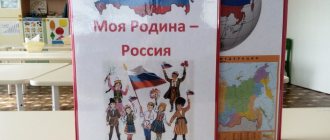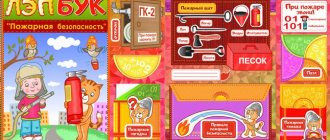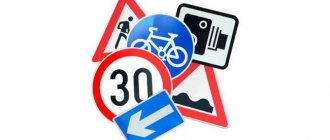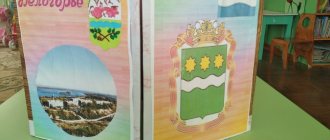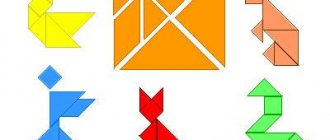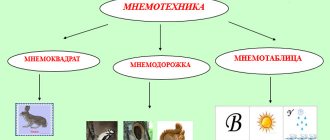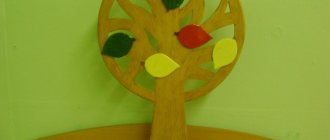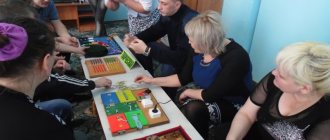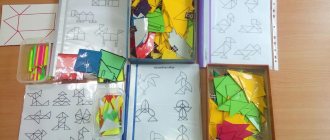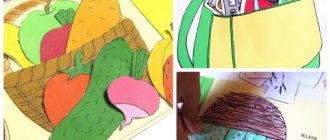What is a lapbook
A laptop is the newest way to organize educational activities with preschoolers. This is play, creativity, learning new things, repeating and consolidating what has been learned, systematizing knowledge, an interesting type of joint activity between the teacher and the child.
The meaning of a lapbook
The methodological manual Lapbook “Entertaining Mathematics” in secondary school was developed with the goal of children mastering mathematical methods of cognition, using educational games, in order to ensure the activity of mental and practical activity in the process of independent and joint activity of preschoolers and adults.
At the first stage, the child is taught to correctly navigate in space, that is, to react to the following moments: left, right, top, bottom, center, above, below, between, clockwise. Over time, the tasks become more difficult.
Note! Already in the fourth year, the child begins to solve addition/subtraction problems, and also consolidates the representation of a number from two smaller ones.
Math laptops
Contained in sections:
- Lapbook. Lapbooks on all topics 7255
- Mathematics. Mathematical representations, FEMP 32862
Showing publications 1-10 of 265. All sections | Mathematics. Math laptop
New
Photo
The best
Lapbook on mathematics for senior preschool age
Teacher of MKDOU kindergarten 7 “Romashka”, Komsomolsk, Ivanovo region. Bystrovskaya O. Yu. Lapbook as a means for consolidating material Didactic games always attract the attention of children. These include colorful pictures and cards in various educational areas. IN…
Making a lapbook “Time”
Today I want to share how I put together a lapbook on the topic “Time”. At the moment I am working with children in the pre-school group. And the theme of time is very relevant. This is my first experience in creating a lapbook . Using a bookmaker, the sheets are stapled. That's how many blanks we got...
What should a math lapbook be like for preschoolers?
Spatial orientation is of universal importance for all aspects of human activity. This term includes various aspects of his interaction with reality. The human psyche is formed from this meaning.
Which math lapbook to choose for preschoolers
Note! Touching all areas of a preschooler’s interaction with any reality, spatial orientation has a beneficial effect on the child’s psyche. Already in the fourth or fifth year of life, the child develops self-awareness, as well as personal qualities. All these phenomena are part of the socialization process.
Lapbook for mathematics senior group is an assistant in:
- understanding and remembering information on the topic being studied;
- the child acquiring the skills to independently collect and organize information on the topic being studied;
- repetition and consolidation of material on the covered topic.
Psychological and pedagogical conditions for the implementation of the basic educational program of preschool education are one of the most important conditions. The teacher’s task is to develop children’s curiosity, their desire to explore this world. It is necessary to be able to choose adequate forms of pedagogical support for each child.
Play is the main and leading activity of preschool children. The preschool educational institution's laptop will help the teacher create conditions for free children's play. This manual is a visual and practical teaching method that meets modern requirements for organizing a subject-spatial developmental environment in the context of the implementation of the State educational standard for preschool education.
Drawing using the “Monotype” technique for children in preschool educational institutions
The educational institution believes that this teaching aid Lapbook “Entertaining Mathematics” is intended for children 4-6 years old.
Expected Result:
- increasing cognitive interest in children;
- effective assimilation of information and consolidation by students of what they have learned in an interactive, entertaining and playful form;
- development of mathematical and communication abilities.
Note! The novelty of the proposed manual is that the use of a lapbook ensures equality of opportunity and the full development of every child. By combining teaching and upbringing into a holistic educational process, a lapbook allows the teacher to build activities based on the individual characteristics of each child, to create conditions under which the child himself becomes active in choosing the content of his education.
For the older group
The main goal of this technique is to create all kinds of conditions so that they are aimed at the formation of spatial representations. During the work, children consolidate and expand their spatial representations: left, right, above, below, in front (in front, behind, next to), and also develop the ability to navigate on a sheet of paper. Every kindergarten teacher should teach preschoolers to indicate in speech the position of one or another object in relation to themselves and another object.
Senior group
Important! The educational program for the senior group is aimed at developing visual-spatial orientation in children. This leads to the development of speech, thinking, and intelligence.
For the middle group
A mathematics laptop for the preparatory group serves to form a logical-mathematical understanding, increase the activation of the thinking process, and develop sensory methods of cognition. For this purpose, kindergarten teachers use educational games. for example, you can consider a didactic game called “Learning numbers.”
Middle group
The main goal of the lesson for the fourth year is to introduce children to the images of numbers in poetry. They learn to understand, develop memory and thinking.
For the preparatory group
A laptop for FEMP in the preparatory group develops logical thinking, attention, and memory of the child. It is much easier to remember the material in a playful way. For example, a math lapbook on the topic “Mathematics Lives Here” is being considered. It acts as a house, which has a certain plot, including the main characters. Among them, “Numbers” stand out. The child's preschool age ranges from 4 to 6 years.
Preparatory group
The main goal is to repeat and consolidate the material covered in mathematics in a playful way. By solving problems on this topic, preschoolers’ knowledge of geometric shapes is improved, counting is consolidated up to 10. Special material is prepared for the work:
- colored paper,
- glue,
- plastic folder,
- satin ribbon,
- magnet,
- tulle,
- beads,
- foamiran.
Finger gymnastics complexes for the senior group
Using a lapbook in 3rd grade math lessons
USING A LAPTOP IN MATHEMATICS LESSONS
IN 3rd CLASS
A laptop is a unique tool for working with children, which is gaining popularity every day. Working with a laptop is interesting for both teachers and students. The laptop can be used in lessons, during breaks, and simply at events dedicated to mathematics. Children learn science in an interesting and entertaining way and consolidate their acquired knowledge.
This is what my lapbook looks like when folded. The theme of the lapbook is “Mathematics around us.” Lapbook format – A3.
IN
When expanded, the lapbook consists of three A3 pages each with thematic tasks in the form of pockets, envelopes, unfolds and flowers.
N
and on the first page at the very top there is a little book about Pythagoras. You can leaf through it and read it. It contains interesting facts about the mathematician. Next to it I placed a mathematical dictation.
Hidden in separate pockets are cards with examples, as well as tasks that require solutions. Cards can be distributed to each student in class.
Z
I placed the tasks in an interesting poetic form into three interactive segments. Since there are many tasks, they had to be divided. The first part was hidden in a paper envelope. The second is in the form of an accordion sweep. The third is on the petals of flower sweeps.
My math lapbook also contains themed crosswords and puzzles. Children solve riddles in this form with particular interest. Another envelope is occupied by a tangram game with diagrams. A tangram is a puzzle consisting of seven flat figures that are folded in a certain way to form another, more complex figure (depicting a person, animal, household item, letter or number, etc.). The figure that needs to be obtained is usually specified in the form of a silhouette or an external contour. When solving the puzzle, two conditions must be met: first, you must use all seven tangram shapes, and second, the shapes must not overlap each other.
N
Despite the fact that on the left side of the laptop there is a poster with the Pythagorean table, thick multiplication cards will also be useful in this laptop. You can play with them, automate knowledge, and use them in your work every day.
The final element of this lapbook is an A4 folder with mathematical coloring pages of varying degrees of complexity. During breaks, students can choose a coloring book with examples, equations, or just numbers and relax while coloring.
Passport of the methodological manual “Lapbook “Who, who lives in the little house?”
Passport of the methodological manual “Lapbook”
“Who-who lives in the little house?”
General description.
Lapbook “Who, who lives in the little house?” is a 2-page themed interactive folding folder. It is made of thick cardboard using self-adhesive film, colored cardboard, illustration material; on the pages of the folder there is a notepad on a spring, baby books, transparent envelopes that contain information on the topic.
Guidelines.
The laptop is intended for children of senior preschool age. An adult should familiarize the child with the rules of the games and play with them. During didactic games, an adult must stimulate the child’s speech activity and encourage correct answers. Having mastered the rules, children can then play on their own.
Target.
Expand, deepen, and systematize children’s knowledge about wild animals (appearance, what they eat, name of home, ability to recognize and name animals and their young). Cultivate an interest in living nature.
The following games are included in this tutorial.
1 Game "Labyrinths"
Target:
develop the tracing function of the eye, attention, patience, memory; practice recognizing and naming young wild animals, reinforce, and teach comparisons of animals based on their feeding patterns.
Material:
pictures with intricate paths, following which the child will find the exit of the path with a pencil.
Form of activity:
together with an adult, independent play for children.
2 Game “Me and My Friends”
Target:
teach comparison of contour, silhouette images of wild animals and correlate them with real images; develop visual perception, memory, attention.
Material:
The game is presented in the form of a small book, in the pocket there is a set of cards depicting contour, silhouette and real images of wild animals.
Form of activity:
joint with a teacher or with peers, independent play.
3 Game “Collect the picture”
Target:
form an idea of a holistic image of an object; learn how to correctly assemble an image of an object from separate parts; correlate the image of the representation with the holistic image of the real object.
Material:
a pocket containing 1 set of cards with images of drawn animals and 2 sets of cut cards.
Form of activity:
together with an adult, independent play for children.
4 Game “Pick up my fur coat”
Target:
learn to compare animals by appearance, consolidate knowledge of the basic colors of the spectrum and their shades.
Material:
1 set of cards with the outline of the animal, 2 sets of colored cards corresponding to the color of the animal’s fur.
Form of activity:
together with an adult, independent play for children.
5 Game “Obedient Fingers”
Target:
develop hand-eye coordination, orientation skills in microspace, attention.
Material:
a notebook on a spring in which children are given tasks (circle the dots, connect the dots by numbers, shade the fur coat).
Form of activity:
together with an adult, independent play for children.
6 Game “Hide the Animal”
Target:
consolidate children's knowledge about the variety of geometric shapes.
Material:
The game is presented in the form of a little book, with a set of geometric shapes in the pocket.
Form of activity:
together with an adult, independent play for children.
Lapbook properties:
— information content;
— multifunctionality;
— the possibility of organizing educational and correctional and developmental activities both with one child and with a subgroup of children;
— didactic properties;
— variability (there are several options for using each part);
— accessibility of structure and content to children of senior preschool age;
— creating conditions for the development of playful, cognitive, research and creative activity of pupils.
Results of using a lapbook in joint activities:
- quick memorization of material on the topic;
— manifestation of increased interest in the content;
— demonstration of independence when working with a laptop.
